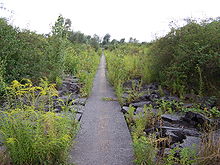Renaturation

Under restoration means the restoration of natural habitats from cultured, used floor surfaces. Theory and practice of habitat restoration with defined requirements is the subject of the scientific sub-discipline of renaturation ecology . The subject of the measures can, among other things, be agricultural areas, melioration areas , abandoned industrial and transport facilities or post-mining landscapes .
In Switzerland, the renaturation of rivers and streams is also called revitalization .
A well-known example of renaturation is rewilding , the renaturation of natural areas by means of the reintroduction of the megafauna previously represented in the respective region .
Areas of application
Moors
The most time-consuming restoration projects include peatland restoration . By u. a. Rewetting be created moor similar habitats.
Flowing waters
In the renaturation of straightened and canalised rivers , attempts are made to restore the habitat quality of the river bed and banks, to create a variance in the flow velocity across the river cross-section in order to reintroduce original animal and plant species. In order to avoid an increased risk of flooding when the overall flow velocity is lower, the flow cross-section is usually increased. For this purpose, the slope of the embankments is usually adjusted or the course of the river as a whole widened. (Examples in Germany: Emscher , Isar , Jagst , Menach , Schlatbach , Schwalm , Sieg , Tauber , Untere Havel , Weschnitz , Wuhle or Wupper and in Switzerland: Aare , Aire , Linth , Simmi or Zihl ) Exemplary measures are the meandering of the Riverbeds, creating gravel banks, river divisions, islands and kingfisher walls.
A special form of renaturation in cities is the disclosure of underground canalised waters ( doles ) to improve the quality of life.
Effect and limits of renaturation
Renaturation usually cannot restore degraded areas or areas that are not in a natural state to the state they were in before the intervention. Among other things, the biodiversity on the renatured areas remains lower than before the disturbance, and the carbon cycle and nitrogen cycle also show lower values after the renaturation than the original ecosystems . The restoration of areas that have been damaged by human use is therefore no substitute for preventive protection of ecosystems.
See also
- Resettlement
- Living Rivers campaign
- Renaturation Ecology
- Recultivation : Remediation of soils that have become sterile through mining or open-cast mining
literature
- The new Isar - renaturation, cultural opening and the flow of ideas ... , Volume I, edited by Ralf Sartori. Buch & Media GmbH, Munich 2010, ISBN 978-3-86520-381-6
- The new Isar - renaturation, cultural opening and flow of ideas ..., The book to conclude the project " Isar Plan " , Volume II, edited by Ralf Sartori. Buch & Media GmbH, Munich 2011, ISBN 978-3-86520-390-8
- Peter Klimesch: Isarlust - Discoveries in Munich , Munich publishing house , Munich 2011, ISBN 978-3-937090-47-4 . The renatured Munich Isar from the Großhesseloher railway bridge to the St. Emmeram bridge.
Web links
Individual evidence
- ↑ Johannes Kollmann: Why renaturation? In: Renaturation Ecology . Springer Berlin Heidelberg, Berlin, Heidelberg 2019, ISBN 978-3-662-54913-1 , pp. 3–12 , doi : 10.1007 / 978-3-662-54913-1_1 .
- ↑ Fränkische Nachrichten: Renaturation: after the Jagst disaster, a large catalog of measures implemented / strengthen the resilience of the water. A diversion is part of the program . October 19, 2016. Online at www.fnweb.de. Retrieved December 18, 2016.
- ↑ a b Fränkische Nachrichten: Renaturation of the Tauber: Complex construction work by the Stuttgart Regional Council increases ecological diversity / costs of over one million euros. New river bed is taking shape . October 27, 2016. Online at www.fnweb.de. Retrieved December 18, 2016.
- ^ NABU: Lower Havel . Online at www.nabu.de. Retrieved December 17, 2016.
- ↑ Wupper renaturation in the Kohlfurth starts on September 2, 2019. In: wuppertaler-rundschau.de . September 2, 2019, accessed September 3, 2019 .
- ↑ Federal Office for the Environment : The Aire renaturation project wins the Council of Europe landscape award. October 16, 2019, accessed October 31, 2019 .
- ^ Peter-J Kramer: Disclosure of city streams worldwide
- ↑ David Moreno-Mateos et al .: Anthropogenic ecosystem disturbance and the recovery debt . In: Nature Communications . tape 8 , 2017, doi : 10.1038 / ncomms14163 .

